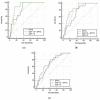Growth Differentiation Factor 15: A Biomarker with High Clinical Potential in the Evaluation of Kidney Transplant Candidates
- PMID: 33419237
- PMCID: PMC7766056
- DOI: 10.3390/jcm9124112
Growth Differentiation Factor 15: A Biomarker with High Clinical Potential in the Evaluation of Kidney Transplant Candidates
Abstract
Kidney transplantation implies a significant improvement in patient survival. Nevertheless, early mortality after transplant remains high. Growth differentiation factor 15 (GDF-15) is a novel biomarker under study as a mortality predictor in multiple scenarios. The aim of this study is to assess the utility of GDF-15 to predict survival in kidney transplant candidates. For this purpose, 395 kidney transplant recipients with pretransplant stored serum samples were included. The median GDF-15 was 5331.3 (50.49-16242.3) pg/mL. After a mean of 90.6 ± 41.5 months of follow-up, 82 (20.8%) patients died. Patients with higher GDF-15 levels (high risk tertile) had a doubled risk of mortality after adjustment by clinical characteristics (p = 0.009). After adjustment by EPTS (Estimated Post Transplant Survival score) the association remained significant for medium hazards ratios (HR) 3.24 95%CI (1.2-8.8), p = 0.021 and high risk tertiles HR 4.3 95%CI (1.65-11.54), p = 0.003. GDF-15 improved the prognostic accuracy of EPTS at 1-year (ΔAUC = 0.09, p = 0.039) and 3-year mortality (ΔAUC = 0.11, p = 0.036). Our study suggests an independent association between higher GDF-15 levels and mortality after kidney transplant, adding accuracy to the EPTS score, an established risk prediction model currently used in kidney transplant candidates.
Keywords: early mortality; growth differentiation factor 15; kidney transplantation; pretransplant assessment; survival.
Conflict of interest statement
The authors declare no conflict of interest.
Figures


Similar articles
-
Growth Differentiation Factor 15 Is Superior to Troponin I in the Evaluation of Kidney Transplant Candidates.Am J Nephrol. 2022;53(2-3):118-128. doi: 10.1159/000521781. Epub 2022 Feb 23. Am J Nephrol. 2022. PMID: 35196660
-
Circulating growth differentiation factor-15 as a novel biomarker in heart transplant.ESC Heart Fail. 2021 Aug;8(4):3279-3285. doi: 10.1002/ehf2.13471. Epub 2021 Jun 10. ESC Heart Fail. 2021. PMID: 34110100 Free PMC article.
-
Growth differentiation factor 15 as mortality predictor in heart failure patients with non-reduced ejection fraction.ESC Heart Fail. 2020 Oct;7(5):2223-2229. doi: 10.1002/ehf2.12621. Epub 2020 Jun 26. ESC Heart Fail. 2020. PMID: 32589369 Free PMC article.
-
VO2peak prior to transplant differentiates survival post kidney transplant.Clin Transplant. 2022 Feb;36(2):e14517. doi: 10.1111/ctr.14517. Epub 2021 Nov 7. Clin Transplant. 2022. PMID: 34679190
-
Who can tolerate a marginal kidney? Predicting survival after deceased donor kidney transplant by donor-recipient combination.Am J Transplant. 2019 Feb;19(2):425-433. doi: 10.1111/ajt.14978. Epub 2018 Jul 14. Am J Transplant. 2019. PMID: 29935051 Free PMC article.
Cited by
-
Persistent lymphopenia after kidney transplantation: increased mortality and decreased homeostatic mechanisms.Front Immunol. 2025 Jun 19;16:1605794. doi: 10.3389/fimmu.2025.1605794. eCollection 2025. Front Immunol. 2025. PMID: 40612959 Free PMC article.
-
Role and Mechanism of Growth Differentiation Factor 15 in Chronic Kidney Disease.J Inflamm Res. 2024 May 9;17:2861-2871. doi: 10.2147/JIR.S451398. eCollection 2024. J Inflamm Res. 2024. PMID: 38741613 Free PMC article. Review.
-
The Impact of the Nephrotoxin Ochratoxin A on Human Renal Cells Studied by a Novel Co-Culture Model Is Influenced by the Presence of Fibroblasts.Toxins (Basel). 2021 Mar 18;13(3):219. doi: 10.3390/toxins13030219. Toxins (Basel). 2021. PMID: 33803529 Free PMC article.
-
The Clinical Value of GDF15 and Its Prospective Mechanism in Sepsis.Front Immunol. 2021 Sep 8;12:710977. doi: 10.3389/fimmu.2021.710977. eCollection 2021. Front Immunol. 2021. PMID: 34566964 Free PMC article.
References
Grants and funding
LinkOut - more resources
Full Text Sources

